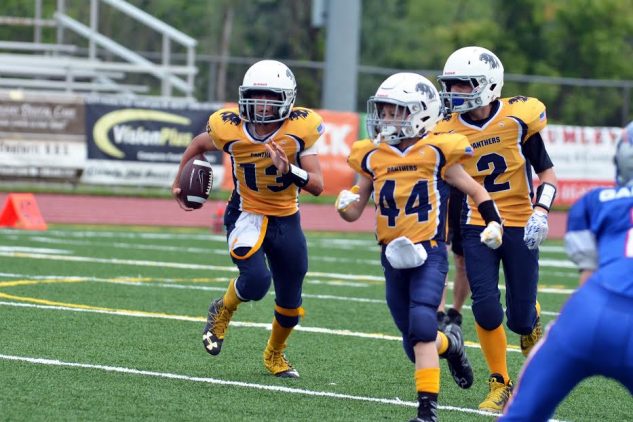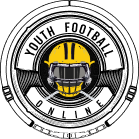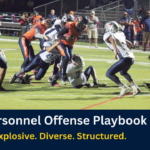Pulling Offensive Linemen in Youth Football | Technique

Pulling offensive linemen in youth football is always a difficult task. Many times players are on the offensive line because they are not able to move well. This means in order for them to be effective pulling they must move efficiently and understand angles. Once they understand these angles they must know how they can use them to complete their assignment.
Technique: Pulling Offensive Linemen in Youth Football
While most offensive linemen are not fast they can maximize their game speed by being efficient in their movements and not having any wasted steps. This starts with the first step of the pulling linemen. While it is critical that the lineman does not false step, when he is pulling his first step must move him closer towards his goal. This initial step serves two purposes. First it opens his hips and shoulders to the direction where he is going. Beyond taking the correct step he needs to throw his pulling side elbow back. By throwing the elbow back he will get his body facing his target. Once he has his hips and shoulders on track he can start to gain the speed and power he needs to deliver an effective block. The second purpose of the step is to gain ground. If the first step only opens his hips and he does not gain any ground he has put himself at a disadvantage to get the defender. Instead this initial step must be outside of his cylinder. If he does not gain ground on this initial step he the defender will have a full step advantage over him.
In general there are two different types of pulls for linemen. The first is a kickout block where the linemen will be blocking a defender who is on the line out so that the ball carrier can run the ball inside of him. The other type of pull is when a linemen serves as a lead blocker for the ball carrier. He could be leading the ball carrier to the inside (like the Power play) or on the edge (like a Sweep or Pin and Pull play). The path, aiming point and mentality of the linemen varies based on his assignment.
Kick-out Block Pull
When the linemen is pulling for a kick out block he has one absolute rule, do not get beat inside. The one thing the puller can not allow to happen is for the defender to get inside of him, this objective drives everything about the block. Because he can’t let the defender inside of him, he will take a checkmark path to his assignment. This means that after he makes his clearance step, he should be heading down hill on a path so that he makes contact with the defender on the defensive side of the ball. This allows him to dig out any defender that might be making a stunt down the line. If he finds that he is in too tight he will be able to adjust so that he can get enough of the defender to free the ball carrier. If he makes the mistake of not getting down the line and tries to adjust to the inside he will normally get beat by the defender. This is why it’s so critical that the lineman gets across the line.
As he goes to make contact he must keep in mind that his primary objective is to not get beat inside. Many times these can be huge blocks where the linemen makes great contact on a defensive linemen but the thing he can’t do is whiff. I tell the linemen that I will never get mad at him for making solid contact and running his feet. We all love the big hit but it’s important to stress not to go chasing the big hit and whiff.
Inside Pulling- Lead Blocking
The other type of pulling block is the lead block. These blocks are slightly more complex and have more variables that the lineman must think about. The thinking of the blocker depends on where the ball carrier is running. There is a different thought process to outside pulling plays than inside pulling plays.
On an inside pulling play the pulling linemen wants to have a downhill aggressive approach to blocking. The most popular scheme that features an inside pulling lineman is the Power play. On the Power play the backside Guard will be pulling around for the playside linebacker. On this play the lineman wants to hug tight to the wall that is being formed by the front side Tackle Guard and Center blocking down. As he comes around the corner he wants to maintain contact with this wall so that he can maintain inside leverage on the playside linebacker. As he comes down the wall he wants to see the playside linebacker and go directly through his inside shoulder so he place himself between the linebacker and the wall. The running back is taught to keep his track tight to the wall and ride that wall to the daylight the emerges as the pulling guard turns the playside linebacker out.
An outside pull is a completely different thought process for the lineman. When he is pulling as a leader blocker inside he being aggressive and creating a space for the running back. When he is pulling to the outside he is now in the Running Back’s world with players who are much better in space. Because of this, his job is to force the defender to pick a side and then rely on the Running Back to make him right. Many times you will see a linemen come around the edge and run full speed at a smaller player and inevitably whiff. Many defensive coaches call this “Semis on Ice.” In these situations because the linemen is moving so fast he can not change directions so it takes only a simple move from a DB to get around the block and make the tackle. The lineman is much better off to slow down and pick a shoulder of the defender to run through. If the defender wants to avoid the block he has to go around the blocker which gives the Running Back a clear path. Many linemen do not like pulling because it puts them in situations that they are not comfortable in. The way to improve lineman’s ability to pull is by giving them simple rules and allowing them to rep it until they are comfortable.
(See Also) Run and Pass Blocking Technique
(See Also) Skip Pulling Technique











